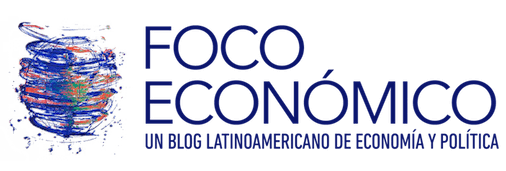The October 2019 social explosion in Chile took everyone by surprise. The scale of protests and the violence of demonstrators had no precedent. Millions of people marched demanding change. Protesters embraced all sort of causes but one demand united them: they were against inequality and privilege. The police responded with force and were accused of multiple human rights violations.
For a long time, economists praised Chile’s market-oriented reforms. Moreover, Chile’s political system and institutions were ranked highly by think tanks such as Freedom House (2019). However, many analysts pointed out that inequality was Chile’s Achilles heel (Edwards 2010). Its Gini coefficient is one of the highest in the OECD although it has declined rapidly; during the last two decades, there has been significant progress in social conditions.
Chile went from being the poorest country in a sample of Latin American countries (jointly with Peru) to having the highest GDP per capita in the region (Figure 1). In 2016, Chile’s Gini was equal to the median in the region (Figure 2). Chile is among the countries that reduced inequality the fastest since 2000: the Gini declined from 56 to 46 between 2000 and 2016 (Figure 3). Other indicators of social progress, such as the Human Development Index,1 rank Chile in the first place in Latin America.
Figure 1 GDP per capita, selected Latin American countries, 1980-2019
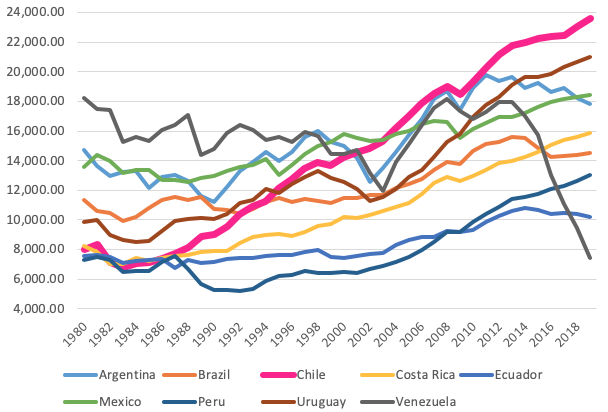
Source: IMF
Figure 2 Gini coefficient, Latin America, 2016
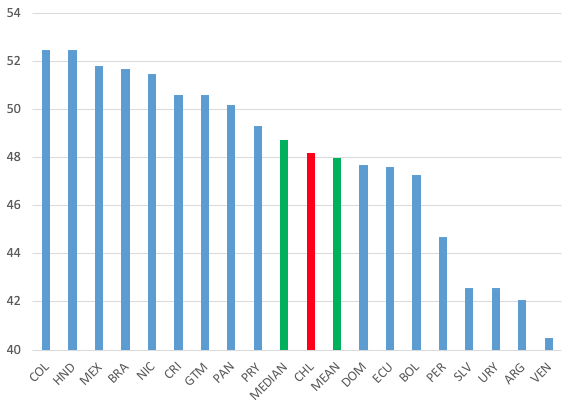
Source IDB
Figure 3 Reduction in inequality (change in GINI 2000–2016)
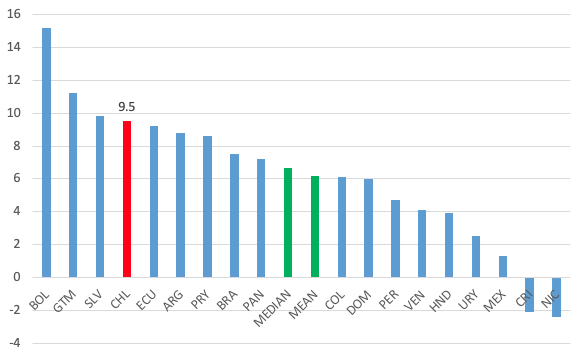
Source: IDB
But behind these rosy data, there is a big paradox. While conventional indicators show a significant decline in inequality, the perception among Chilean citizens is that inequality has greatly increased (Figure 4).
Figure 4 Change in perception of inequality
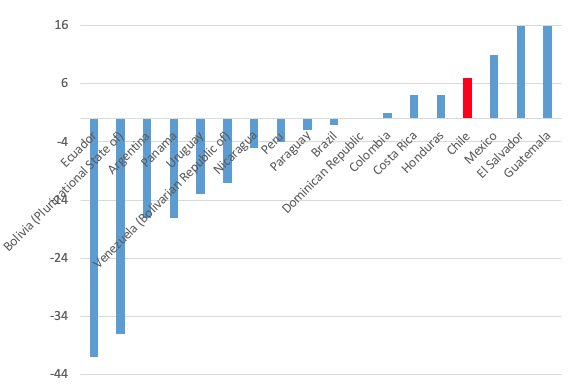
Source: ECLAC
This contrast between reality and perception constitutes ‘Chile’s paradox’. There are three possible explanations for it.
The first is that we are talking about two different meanings of inequality. While most economists focus on income inequality, there is a broader concept that includes quality of life, social interactions, access to basic services, the nature of interpersonal relations, and the degree of ‘fairness’ of the political and economic systems.
Second, it is possible that people do not realise that conditions have greatly improved. It is conceivable that the narrative about the county’s social and economic trajectory has been captured by the critics of neoliberalism. These critics may have convinced the people that, in contrast with reality, things have been moving south for many years. This is a ‘veil of ignorance’ type of argument.
The third possible explanation is that people recognise progress but believe that things are moving too slowly. This is an ‘impatience’ argument that compares reality with aspirations. The disconnect between reality and aspirations is captured vividly by the privately run pension system. While people expected – and were promised – a high replacement rate, this has been, on average, a very low 30% (Edwards 2010).
Vertical and horizontal inequality
There is some truth in every one of these explanations. Having said that, the most interesting factor behind the paradox is related to different notions of inequality. It is useful to distinguish between ‘vertical’ (income) inequality and ‘horizontal’ (social) inequality. While the former is narrowly defined and can be measured with some degree of precision, the latter is a somewhat vague concept that often depends on how people perceive their lives and social interactions with others in their communities and workplaces.
During the last few years, the OECD has made an effort to analyse a broad array of indicators of social conditions and quality of life that add up to a comprehensive notion of horizontal inequality (see the OECD’s Better Life Index).2 As it turns out, Chile does poorly in almost every one of these indicators.
In Table 1, I provide a list of the eleven components of this Better Life Index. I show Chile’s ranking within the 40-countries sample (most of them OECD members), and I provide information on which Latin American country is the most highly ranked in each category.
Table 1 Chile and the OECD’s Better Life Index
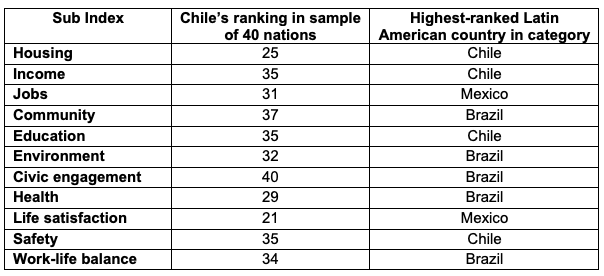
Source: OECD Better Life Index
When Chile is compared with the other Latin American countries in the OECD sample (Brazil, Colombia, and Mexico), the picture that emerges is checkered and ambiguous. Chile is ranked first in only four of the 11 indicators and is dead last, within the 40 countries sample, in ‘Civil engagement’.
In contrast, when traditional measures are used, Chile is always ranked first among these Latin American nations, often by a wide margin. Take per capita income and the Gini coefficient. In 2018, Chile’s GDP per capita (PPP) stood at $23,000, Mexico’s at $18,000, Brazil’s at $14,500, and Colombia’s at $13,600. Regarding the Gini, Chile has the lowest degree of inequality in this (small) sample; according to ECLAC, in 2017 the Gini was 0.43 in Chile, 0.54 in Brazil, 0.51 in Colombia, and 0.50 in Mexico.
The above discussion, then, shows that as soon as one moves to broader measures of horizontal inequality, the view of Chile as Latin America’s paradise becomes somewhat blurred.
A number of studies undertaken by the United Nations Development Programme during the last decade (e.g. UNDP 2017) show that for some time there has been a subterranean dissatisfaction among Chile’s population, a sense that the playing field is not even, that the elites enjoy gross privileges, that access to social services is profoundly skewed. There is a growing sense that private firms can collude and abuse workers and consumers without being penalised, and that the education and health systems are profoundly segregated. In short, a large fraction of the population believes that there is a dark side to modernisation.
In Chile, the hypothesis of brewing unhappiness received the name malestar – possibly the best translation of which is ‘malaise’ or ‘restlessness’. According to a number of intellectuals, the development model followed since the 1980s was successful in generating growth and reducing poverty. But, at some point in time it stopped being effective and needed major adjustments. What worked in a very poor nation was not appropriate in a country with a growing middle class with massive aspirations and a sense of vulnerability. This middle class wanted better social services, better health, better education, and better pensions; it wanted more solidarity, and fewer privileges for the elite. People wanted more horizontal equality; people demanded respect and dignity (Edwards 2016).
The malestar hypothesis was systematically rejected by conservative intellectuals, who argued that people were satisfied with the neoliberal model. It was claimed that, although people had some grievances about aspects of the development strategy, they were satisfied with their lives, and that the model did not require major adjustments or changes. This perspective was at the centre of presidential candidate Sebastian Piñera’s economic and social platform during the 2017 presidential campaign (CEP 2017).
Days of fury and the future
Chile’s uprising was triggered by a modest (3%) increase in Santiago’s Metro fares. As a way of protesting, local high school students decided to jump the Metro turnstiles. Through social media, they called their movement Evade and pointed out that the elite – including the president – systematically evaded taxes and that it was the people’s turn to dodge Metro fares.
After a series of unfortunate decisions by the government, the movement gained momentum and peaceful demonstrations ensued. People who rejected low pensions, highway tolls, school segregation, low-quality education, and poor public health services joined the marches.
At the same time, anarchist groups that in the past had planted bombs in the Metro sprang into action. On 18 October, 20 Metro stations were simultaneously set on fire. The police reacted with force, firing tear gas and rubber bullets. Demonstrations became even more massive and spread throughout the country. On 25 October, more than a million protesters congregated in Santiago. At that point, and for almost 30 days, a daily routine took over: it began with peaceful demonstrations around 4 PM. At dusk, the demonstrations become violent, when anarchists and extremists set supermarkets, pharmacies, churches, government offices, restaurants, hotels, shops, and banks on fire; they set barricades in streets and boulevards. They even set a hospital on fire.
Rumours and fake news spread through social media, and the country became paralysed. Demonstrations, looting, rioting, and repression reinforced each other in a horrible circularity, in a spiral of sorrow and destruction.
On 14 November, 11 political parties negotiated a way out of the crisis. The core of the agreement is a constitutional convention that will draft a new constitution to replace the one enacted by Pinochet in 1980 (and amended more than 200 times since the return to democracy in 1990). Members of the convention will be elected in October 2020 and will have nine months to write the new document. Then a plebiscite will be held, to approve or reject the new constitution.
There is very little certainty on what will happen, going forward. In fact, at the time of this writing, it is not known if the violence will stop and if the country will regain some degree of normality. Only a few things are clear; here are four of them:
- From an economic perspective, and as a consequence of the rioting and destruction, Chile will experience significant hardship. Unemployment will skyrocket, foreign investment will decline, and capital will leave the country.
- Chile is likely to become a more egalitarian country; progress will take place, especially, in the horizontal inequality front. Improvement will be slow but will happen. Whether the country will slip into populism is an open question (Edwards 2019).
- The new constitution will depart significantly from the Pinochet one. It will give a central role to the state in economic and social affairs and will guarantee, at the constitutional level, enforceable social rights such as education and health.
- The neoliberal experiment is dead. It is likely to be replaced by a welfare state that will attempt to follow the Nordic countries. Whether Chile will succeed in this new experiment is the big question.
References
Centro de Estudios Publicos (2017), “La modernización y la paradoja del malestar en Chile” (“Modernization and the ‘malestar’ paradox in Chile”), El CEP presenta on YouTube, 6 March.
Economic Commission for Latin America and the Caribbean (ECLAC), CEPALSTAT.
Edwards, S (2010), Left behind: Latin America and the false promise of populism, Chicago: University of Chicago Press.
Edwards, S (2016), “La derecha no admite que el modelo se agotó, y la izqueirda que fue exitoso” (“The right doesn’t acknowledge that the model is exhausted; the left doesn’t recognise that it was successful”), El Mostrador, 14 March.
Edwards, S (2019), “On Latin American populism, and its echoes around the world”, Journal of Economic Perspectives 33(4): 76–99.
Freedom House (2019), “Freedom in the World 2019”.
International Monetary Fund (IMF) (2019), World Economic Outlook Database, October.
Inter-American Development Bank (IDB) (2016), “Statistics on poverty and income inequality in LAC (18 Countries): Inequality in the distribution of per capita income in LAC”, December.
United Nations Development Program, (2017), “Chile en Veinte Años”.
